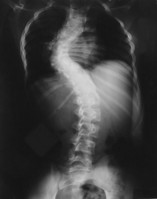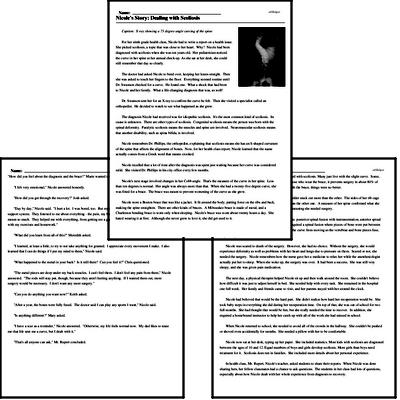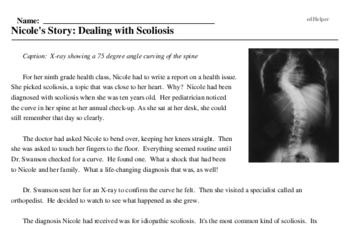Nicole's Story: Dealing with Scoliosis
Caption: X-ray showing a 75 degree angle curving of the spine
For her ninth grade health class, Nicole had to write a report on a health issue. She picked scoliosis, a topic that was close to her heart. Why? Nicole had been diagnosed with scoliosis when she was ten years old. Her pediatrician noticed the curve in her spine at her annual check-up. As she sat at her desk, she could still remember that day so clearly.
The doctor had asked Nicole to bend over, keeping her knees straight. Then she was asked to touch her fingers to the floor. Everything seemed routine until Dr. Swanson checked for a curve. He found one. What a shock that had been to Nicole and her family. What a life-changing diagnosis that was, as well!
Dr. Swanson sent her for an X-ray to confirm the curve he felt. Then she visited a specialist called an orthopedist. He decided to watch to see what happened as she grew.
The diagnosis Nicole had received was for idiopathic scoliosis. It's the most common kind of scoliosis. Its cause is unknown. There are other types of scoliosis. Congenital scoliosis means the person was born with the spinal deformity. Paralytic scoliosis means the muscles and spine are involved. Neuromuscular scoliosis means that another disability, such as spina bifida, is involved.
Nicole remembers Dr. Phillips, the orthopedist, explaining that scoliosis means she has an S-shaped curvature of the spine that affects the alignment of bones. Now, for her health class report, Nicole learned that the name actually comes from a Greek word that means crooked.
Nicole recalled that a lot of time after the diagnosis was spent just waiting because her curve was considered mild. She visited Dr. Phillips in his city office every few months.
Nicole's next stage involved changes in her Cobb angle. That's the measure of the curve in her spine. Less than ten degrees is normal. Her angle was always more than that. When she had a twenty-five degree curve, she was fitted for a brace. The brace was meant to prevent worsening of the curve as she grew.
Nicole wore a Boston brace that was like a jacket. It fit around the body, putting force on the ribs and back, making the spine straighten. There are other kinds of braces. A Milwaukee brace is made of metal, and a Charleston bending brace is worn only when sleeping. Nicole's brace was worn about twenty hours a day. She hated wearing it at first. Although she never grew to love it, she did get used to it.
Two to three percent of schoolchildren are diagnosed with scoliosis. Many just live with the slight curve. Some, though, need a brace like Nicole did. In fact, for those who wear the brace, it prevents surgery in about 80% of cases. Unfortunately for Nicole, after two years with the brace, things were no better.
Nicole could visibly see the changes. One shoulder stuck out more than the other. The sides of her rib cage were different heights. One hip appeared higher than the other one. A measure of her spine confirmed what she already knew. Her Cobb angle measured over 50, meaning she needed surgery.




